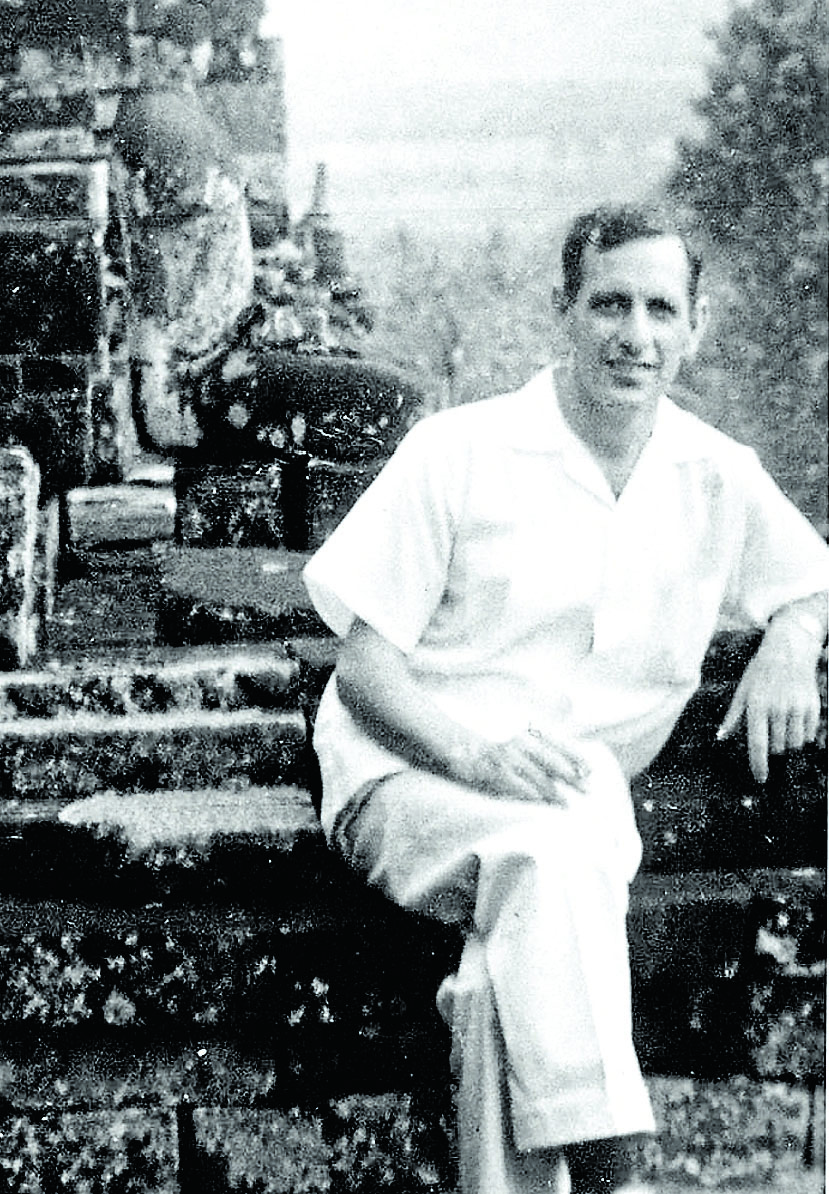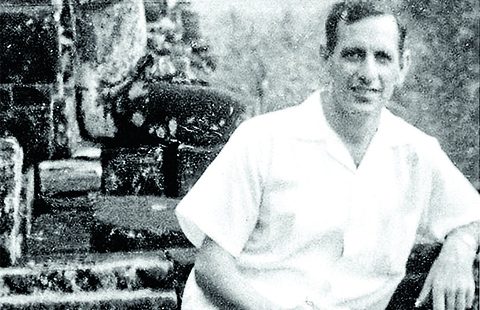
Professor John Legge at Borobudur, Java. Photo supplied by Kate Legge.
John Legge AO, FASSA, FAHA (1921-2016)
Anthony Milner pays tribute to a historian, Southeast Asianist, and institution builder.
In the words of former President of the Asian Studies Association of Australia, Elaine McKay, John Legge more than any other was the founder of modern Asian Studies in Australia. In the great expansionist period of the Australian university system he was (as Professor of History, and then Dean of Arts) a leader in the building of Monash University – and also in the vital interaction between academic analysts and government policy-makers. Through his international and Australian networks, and growing numbers of students, he influenced Australia’s engagement with Asia. Internationally, Legge was especially recognised for his writing on Indonesia – and also as a theoretician in the discipline of history.
A graduate of Melbourne University and Oxford, Legge’s early writing was on colonial government, with major books on Papua and British Fiji. The Papua project on Australia’s administration of the territory arose from Legge’s wartime work in the government’s Directorate of Research and Civil Affairs, which was headed by the extraordinary Alf Conlon, and recruited also the poet James McAuley and future Governor General John Kerr. At the University of Western Australia in the immediate post-War period (1946-1960) Legge was also a pioneer in the teaching of Asian history. Prominent government minister Fred Chaney, Ambassador to Japan Sir Neil Currie, and others, spoke in later years of how his survey course changed their lives. These years in Western Australia, working in the department of history founded by Fred Alexander and living in St Georges College under the wardenship of the respected and eccentric “Josh” Reynolds, were particularly happy ones for Legge. It was here that he met and married, in 1952, the beautiful and talented Alison Hale, a fellow Oxford graduate and the star of a legendary local production of Shaw’s St Joan.
In 1956 Legge and Alison took sabbatical leave at Cornell University, the pre-eminent centre of Southeast Asian Studies in the United States. Here Legge was inspired by the academic leadership of George Kahin, with his focus on modern Asia not Orientalism, his (often critical) engagement with Washington and his network of relations with the rising new elites of post-colonial Southeast Asia. The great Indonesianist, Herb Feith, who knew both men well, once reflected that despite their many common perspectives, Legge’s “emancipatory liberalism” was “more playful and sceptical”.
Legge’s particular Australian style was shaped in part in western Victoria (at Warrnambool State School and Geelong College). His father was a Presbyterian clergyman; and his great grand uncle was the famous missionary, James Legge, the translator of Confucius and first professor of Chinese at Oxford. In the midst of academic debate, John Legge’s face – like that of his ancestor – could assume an expression of Protestant tenacity.
At Melbourne University Legge studied in the Department of History – at a time when its influential professor, RM Crawford, was questioning the nature of history as a process of inquiry, and also warning Australians that the age of European empires had ended, and that they must now come to terms with the societies of the new Asia Pacific. In future years Legge addressed these two themes himself as an academic leader, especially when he moved to the new Monash University as foundation professor of History in 1960.
Established in Melbourne with Alison and their three children – David, Catherine and Colin – Legge set about recruiting a department of History which was soon regarded as one of the finest in the country. It was distinguished by a fresh approach to the study of theoretical issues, an extraordinary range of expertise – including some of Australia’s most prominent specialists in Australian and European history – and a collegiality which is today still a hallmark.
Legge was also central in developing the Monash Centre of Southeast Asian Studies – modelling it in some ways on the Cornell Centre, and achieving a wide international reputation for Australia as well as Monash with amazing rapidity. The first Southeast Asia specialists who came to Monash – including Herb Feith, Cyril Skinner, Michael Swift, Ian Mabbett, Jamie Mackie and Milton Osborne – were renowned in their various fields and gave young Australians immediate access to distinguished institutions in the United States, Britain and Europe. Monash was also now equipped to contribute to the development of Southeast Asian Studies in the region itself – Legge, for instance, spending 1969-1970 as Director of Singapore’s today-famous Institute of Southeast Asian Studies. One of his initiatives there was to institute weekend seminars where public servants, business people and journalists could interact with academics. As always, he believed an academic institution “should not be an ivory tower”.
In his own academic writing following the Cornell sabbatical, Legge’s principal focus was Indonesia – which he recognised as a country of the highest possible importance for Australians to understand. The first Australian historian to devote himself primarily to the study of Indonesia, his initial research was on regionalism and local government, a topic of vital importance today – and one for which Legge’s work on Papua and Fiji had been useful preparation. In his field trips to Indonesia he collaborated closely with key Indonesian officials and scholars, including the future Ambassador to Washington, the intellectually charismatic Soedjatmoko. Legge later (1988) published an important study focussed on Soedjatmoko’s brother-in-law, the socialist political figure, Sjahrir, but his best known works on Indonesia are a fine, beautifully-written biography of Indonesia’s founding statesman Sukarno (first published in 1972) – a man who had troubled many Australians – and a highly-innovative general history, Indonesia (first published in 1964).
The general history is remarkable in bringing together Legge’s desire to understand Indonesia – especially the historical processes which have shaped the country – with his commitment to making theoretical advances in the discipline of history. Indonesia is an achievement in inter-disciplinary collaboration, with the historian Legge – responding to some extent to his old teacher, Crawford’s claim that the practice of history is itself fundamentally scientific in character – reaching out to a range of social scientists. In particular, Legge saw the way the imaginative, illuminating concepts developed by the American cultural anthropologist Clifford Geertz could deepen an historian’s understanding of Indonesian society and the manner in which Indonesia was changing. Geertz, who went on to become America’s leading anthropologist, acknowledged that it was Legge more than any other scholar who had brought the disciplines together in Indonesian studies.
Alison’s illness, diagnosed in the late 1970s was a blow that the couple met with dignity and fortitude. Legge faced the untimely death of his 52-year-old partner in life with a strength which may have drawn on his childhood in the manse and the early death of his own mother. A second, 16-year, marriage to Jane, a fellow Indonesianist, brought new happiness, intellectual stimulus, and an enduring friendship.
An outstanding publication in Legge’s later career was a long and internationally-famous essay in The Cambridge History of Southeast Asia (1992): a survey of the whole field of historical writing on Southeast Asia. This much-quoted essay combined, as no other contemporary historian could, a vast professional knowledge of the range of research that had been undertaken with an intense philosophic interest in comparing the methodological and theoretical approaches that shaped these studies.
It was from his strong academic foundation in history and Southeast Asian studies, that Legge played a broader role in Australian public life. His students – many inspired by his rigorous interest in problems of analysis and interpretation – went to key academic positions all over the country, and have held influential positions in the Department of Foreign Affairs and Trade and other government departments. Legge himself was comfortable in playing a national role, and was unapologetic in doing so as an academic and intellectual. He was at his most active at a time when Australian universities were expanding and highly prestigious.
In a spirit of civic as well as professional duty Legge supported research and educational projects which he believed would help the nation, and accepted high office in a range of public institutions. He was for many years a guiding influence in the Australian Institute of International Affairs (writing its history in 1999) and the Asian Studies Association of Australia, and played a large part in numerous major forums and ‘teach-ins’, especially relating to Australia’s engagement with Asia. He was prominent in the contest over Vietnam, debating against BA Santamaria, Geoffrey Fairbairn, Frank Knopfelmacher and other Australian supporters of the American-led campaign. From 1987-1993 he was an Executive Member on the Victorian Curriculum and Assessment Board and for many years he chaired the Department of Foreign Affairs Editorial Advisory Board for the series ‘Documents on Australian Foreign Policy’.
Legge’s students and colleagues will best remember his delight in debate, fundamental fairness and personal warmth. He was determined that Australia should be in the vanguard of international historical research, particularly with respect to Southeast Asia. His combination of open inquiry – his intense desire to understand historical patterns and processes – and confident scepticism offer still a valuable standpoint, including in the great Australian task of achieving an effective accommodation with the societies of the Asian region.
Anthony Milner was Basham Professor of Asian History at the Australian National University, 1994-2013. He is currently Emeritus Professor, and also Professorial Fellow at the University of Melbourne.
This is a longer version of an article first published in Fairfax media.
 Facebook
Facebook  Twitter
Twitter  Soundcloud
Soundcloud  Youtube
Youtube  Rss
Rss 